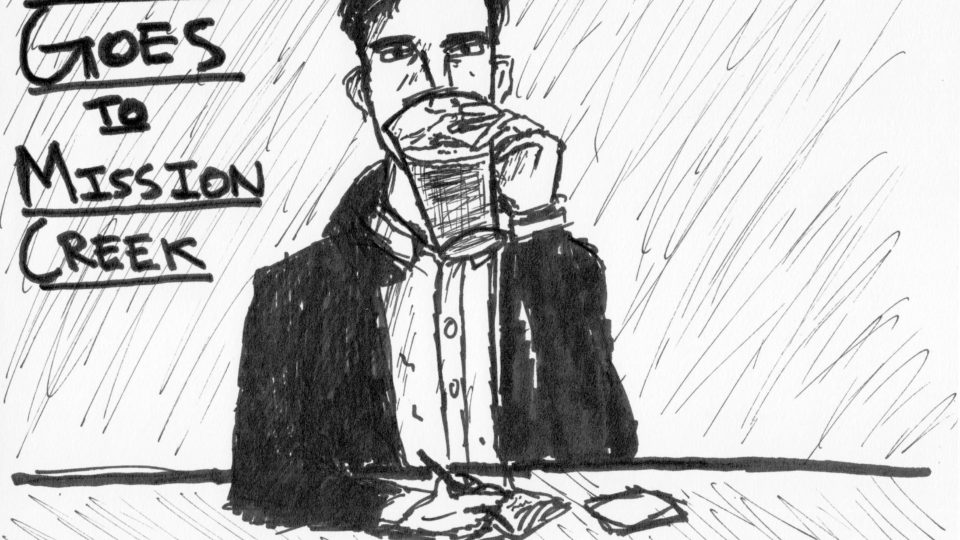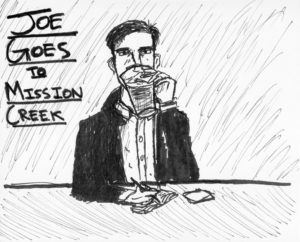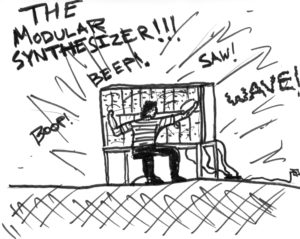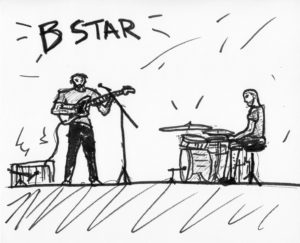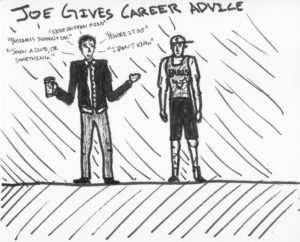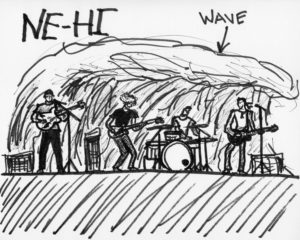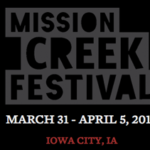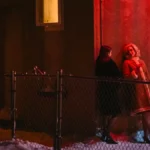Wednesday, April 1st, 2015
6:26 PM
FILM SCENE: I Dream of Wires
Note: The opinions and ideas in this piece only reflect those of the moron author and not that of KRUI FM or its staff.
Woke up with slight difficulty this morning, but being a nighttime gent anyway, I get through my day with a steady stream of coffee and a few bags of Chex Mix of the bold, party-blend variety so by the time I reach FilmScene, last night’s crimes and glories stay behind me and I am ready for day two of Mission Creek. I arrive at FilmScene, the local art house cinema and purchase a ticket for the film I Dream of Wires, a documentary about the history of the modular synthesizer. Knowing the great power of FilmScene’s sound system (I saw Purple Rain here last Saturday), I’m pining to hear the waves and saws of Moog’s and Buchla’s through these speakers.
I think back on the synthesizer and all of the bands that use it. It’s a source of both good and evil in music, so I don’t want to see a puff-piece of propaganda that conveniently forgets Styx, Rush, and other evil, historical uses of the synthesizer. I also expect this film to correctly pronounce Robert Moog’s name (it’s mow as in mow the lawn, and then your standard soft g). The audience here is quite possibly the nerdiest I am a part of all week. This is, after all, a screening of a two-hour long documentary about synthesizers at an independent film theater. The only thing nerdier than this event in the festival’s schedule occurs in this same theater, and that’s a live film scoring session by director Jim Jarmusch’s noise band Sqürl. Word on the street is the show sold out in minutes, and unfortunately, my press credentials (funny, right?) could not get me a spot. I will see their rock show at the Yacht Club this Saturday, however.
This film, I expect, will be very, very cool. Before the film begins, Ian MacMillan, also known as Phosphines, opens the screening with a brief overview of how modular synthesizers work. He then shows off his sweet rig and promises us a demonstration. It’s got two configurations: Moog and Eurorack. Don’t worry, I don’t know what the hell this stuff is either, but everyone else in the audience giggles with enthusiasm when Ian makes jokes that don’t register with me. It’s like being a child sitting at the grown-up table. His earnest remarks are refreshing; it’s really endearing to see Ian and these folks in the theater talk shop. I sit back and embrace the opportunity to learn more about this star destroyer control panel that people use to make music.
“This mess of wires has everything you see on a synthesizer: filters, envelopes, noise source, delay; you know, run-of-the-mill stuff,” says Ian. Yeah, sure, run-of-the-mill, I think to myself. Ian’s passion for experimentation, routing this module to that, patching there, patching there, is admirable and what little knowledge I have gives way to me trusting his sheer enthusiasm.
Ian finishes his talk and enters his laboratory, workstation, whatever. He tells us he will play the Moog first and then the Eurorack. The theater lights don’t dim, they turn off completely and the room is dark, except for the lights of his synthesizer. The volume cranks up and the Moog sounds as if the voice of god and a swarm of locusts burst from the darkness and into our heads. I try to scribble notes in darkness and fail spectacularly, so I put away them away and let the Moog absorb me. I think in words: Glory. Galactus. Gargantuan. Then Ian moves to the Eurorack and we descend into hell rendered in bits. I’ve never had a concussion before, but these could both sooth a concussion and induce one. I struggle to endure the barrage of sound and I’m convinced Ian is trying to kill us with the Eurorack. It’s deafening at one point and it sounds like a bottle rocket exploded on a marimba inside a whale’s ass.
Ian ends his set by turning the volume down. Fades it like a pro. The film begins. There is a near-constant visual motif of machinery, knobs, wires, and modules being prodded and poked with hands. The hands on knobs suggest the relationship between man and synth: it is man manipulating a naturally occurring process into music. Obviously, I’m not a scientist, just a hack writer whose work could double as post-bong hit wisdom, but it really is quite something to harness power like that and create truly mesmerizing music that relies on pure sound. It’s potent stuff to hear and to play.
The film introduces us to all the key players in the early days of synthesizers. They set it up like the classic east coast/west coast rap feud, a la Tupac and Biggie, except with probably the whitest dudes to set foot in America after the Mayflower. The east coast guys are squares, led by Robert Moog, an inventor who markets his modular synthesizers to mainstream musicians by attaching a keyboard to it. This runs contrary to the hippies on the west coast, led by Dan Buchla and the San Francisco Tape Music Center, who wanted to abandon old forms of composing (i.e., keyboards) and notation and replace it with experimentation through math and wave science. The film shows the innovations from each coast; Buchla built a board that creates sound by sensing the amount of voltage-conducing skin planted on it. Buchla also invents the sequencer. Each coast released albums that demonstrated their instruments’ strengths: Silver Apples of the Moon with the Buchla and Switched on Bach with a Moog. The mainstream eventually favored the Moog when a few of their salesmen attended the 1967 Monterrey Pop Festival and musicians shelled out tens of thousands of dollars for these massive, six-feet tall units.
The film has suddenly morphed into a two-hour pissing contest between men addicted to purchasing walls upon walls of knobs. Of course these guys don’t like the punks. They loathe the punks. In fact, they consider themselves more innovative and basic than the punks because modular synth guys only need one finger, maybe two, to play their instruments. They also don’t care for the synthesizers that most people can actually afford, especially anything built by Yamaha. The knobs motif haunts me. Men have some rooms where it’s just knobs upon knobs. Quite the commitment if your instrument of choice festers across your room like vines or graffiti. And yes, there is heavy Freudian feel when men talk about their knobs like a fetish.
“The 1980’s were a dark time for modular synthesizers,” says the voiceover. Oh no! More men talk about the crappy Casio’s and Yamaha’s that took over the market share. Dark times indeed when regular folks can finally purchase a once cumbersome and expensive piece of technology and play with it on their sofa.
Some later segments of the documentary are actually interesting again, especially when the younger generations get a chance to speak. Dance and house music ends up saving the day for the modular synthesizer, and Dub Taylor expresses his love for the modular synthesizer in a wonderful German accent with the line “so much bass.”
And then the film relapses back into more talk between gear junkies. People are now building affordable twelve-feet tall walls of knobs. Merry Christmas. I think I’ve learned everything I’ve ever wanted to know about modular synthesizers. Watching someone play one is like watching a guy at his desk endlessly fitting cables into sockets, as if he’s fixing a TV, but never, ever fixes the damn TV and continues pulling out cables and pushing them in elsewhere. What the enthusiasts call “experimentation” looks more like troubleshooting. You also can’t tell if they’re actually playing the damn thing well. You could put an amateur and a professional in front of me and I would not be able to tell the difference. But maybe it’s like fine wine; I’d probably not know the difference between the box stuff and the bottles that gather dust because my palette isn’t as sophisticated, but blindfolded sommeliers, despite their learned tongues, would pick Franzia over some old-ass bottle from Cotes De Nuits.
Parts of the scenes where these people confess their addictions to bulking up their modular synthesizers bears a striking similarity to the TV show Intervention; they explain how they found themselves stuck in a loop of throwing money at a habit they don’t enjoy anymore because they’re searching in vain and in costlier and more magnificent volumes for that sweet high that their first taste gave them, and they just keep subjecting themselves to this torture for years, maybe decades. I mean, do these people ever hit the record button, or do they simply salivate over these machines and the possibilities they provide? It’s depressing. Can one really tell with meaningful precision between this saw and that wave? Really? How much do you think Renoir or Monet deliberated over this or that paint? Eventually they had to paint the damn canvas, and they would’ve painted masterpieces with mud if they had to.
****
As you’ve read, this was not a fun experience for me. It’s too long. So is this column. I ended up writing way too much about my struggle to endure this film and in my notes I eventually compared myself to Teddy Roosevelt contemplating suicide on his Amazon River adventure. If I, a self-professed audiophile, am unable to write more about modular synthesizer, then you, dear reader, most likely would not want to read more about modular synthesizer. Moving on.
9:05 PM
THE MILL: John June Year, B Star, Ne-Hi
I arrive late and local band John June Year is on stage and grooving. I’ve seen them before and I’m not too happy to happen upon them now after sitting through that long ass film. I hope they can change my opinion of them. That happens from time to time. The band has all the parts of a solid group. They have good taste in equipment- Vox amplifiers, classic Fender and Epiphone guitars, and they’re sufficiently loud. Handsome men too, and they have great confidence in their mission. John June Year also knows a thing or two about how to manipulate dynamics for emphasis amid repetition. But you see, everything’s there except the nuance. It sounds like a rock band, that’s for sure, but I’m not sure if this band is better when I sit in the same room or when I hear them through a wall. Again, all the ingredients of a good band are right there on stage, and they’re really selling it with their cool, intense yet apathetic faces, but like the film version of Frankenstein, the monster has all the parts of a real man and it’s certainly alive, but the beast is slow, bland, and without much character except bragh! and fire!
These are definitely capable musicians and I’m sure they’re gentlemen, but their shtick, or lack thereof, pushes me to survey Wednesday night’s crowd at the Mill. Right now, a dedicated few stand for John June Year. Friends? I don’t know. I recognize one as a local wannabe punk. Definitely has a shtick: hubris in a goofy shirt. I think he used to live in a dumpy Iowa City historical site where he and his friends would host bands, but really, these guys just wanted to party. The place is legendary, according to him and only him. Ask anyone else, and they’ll say, “oh yeah, that shithole where a few bands played? Yeah those guys are idiots.” They occupied that house last year, and now it seems he is old enough to legally purchase alcohol, because he’s standing there with a PBR in hand, reveling in his awful and contrarian taste. Good. Maybe now that Iowa City’s Finest no longer clobber his cranium with billy clubs and spray his eyes full of pepper spray, he can finally assess the poor decisions in his life that have led him here, standing docile in front of an underwhelming band. OK, I’m being harsh. I’ve not gotten a beer yet. For all I know, these are capable, good people, albeit people with shtick learned not experienced. Johnny Rotten, Nick Cave, Prince, Nicki Minaj, you name them; they lived their shtick, experienced it. You can’t just take the punk thing because it’s cool and flip a switch ON and become a punk. I don’t really know what punk is, but I suspect I know what punk isn’t; it’s not about fighting cops, doing drugs, and making intentionally shitty music. Maybe in the seventies that’s what punk was, but when these guys do it, it looks like a bunch of privileged white dudes acting like children. And to be punk in Iowa City is like being in a reggae band in Omaha, Nebraska; it’s downright idiotic. This is not a city that produces a local counter culture. This is a nice town! What the hell is there to rebel against? Corn? The farmer’s market? The cheap beer? The touring bands you can see for less money and with less people? Things are good here! This isn’t New York City or London. It’s not even Twin Cities. Punk is dead, anyway. Move on and ask yourself this question: Are you here for the music or for the drugs, and which is accessory to the other? Take some time to think about that one.
This line from John June Year interrupts my thoughts: “I know you can’t be seen with a boy like me.” I glance at the source and wonder why someone could not be seen with this “boy” who is clearly a man. Oh, what prejudices deem associating with a white man taboo these days? Perhaps someone would be ashamed to be associated with you and your music? Is that it? Maybe it’s an upbeat song about womanizing during Apartheid, but I fail to see what may have led him to believe that someone in this modern day and age would ever have a second thought about being seen with a man like him. Everyone wants to be a rebel. Twain wrote about the gilded age, when people bought into fantasy and completely missed their own issues. This is the gilded band. John June Year exits the stage and the singer makes one last attempt to sell their shirts, which are now five dollars, a markdown, according to him. A markdown to wear your unfortunate association with this band like a scarlet letter.
It’s an experience like this that makes me thankful for being on the guest list and receiving incredible service from the bar staff. As I stand waiting for another beer, one of the bartenders comes up to me and I wave him away, “thanks, I’m being served!” Then, another bartender walks up to me, “yeah, being served, thanks,” and yet another bartender, “nope, quite alright, being served.”
B Star takes the stage. It’s a simple set up, a guitarist and a drummer. They shuffle about shyly, adjusting this pedal and that tom skin; make sure the ride cymbal is high enough. Drummer’s got a short kit at his knees. Those always look cool because the drummers who use shorter kits look like they’re only using their elbows. I don’t know what to expect out of this band. They have microphones set up for both members, and the guitarist speaks into his: “Hey, what’s up? We’re B Star.”
He steps back from the microphone and plays a few chords; B minor to G major, or something like that transposed elsewhere. They’re the ones who need to know the theory, and from the onset, it’s obvious they know the theory very, very well. The guitarist plays over the chords, and that’s when I realize he’s been looping and playing against himself. Sure, the layered looping guitar sounds like cooperation, but what sets these B Star guys apart is that the notes he’s playing aren’t quite polite to the rest of the loop. It’s in key, but there’s a bit of irreverence in his notes. They’re not loud, distorted guitar notes, they’re clean, almost sharp tacks emanating from his Jazzmaster’s pickups. It’s beautiful. Using mallets, the drummer backs him up with some light flourishes on the toms and then crescendos into cymbal crashes and aggressively cascading fills. The real musicians have entered the building.
The next song starts with a few polyrhythms layered on top of each other on guitar. I’m reminded of Dustin Wong’s work. The drummer punctuates every root note like a homerun. I’m giddy. The drummer doesn’t seem to cross his arms when he plays. He’s damn precise and full of energy, as if he just turns up a dial on his body and that makes him faster, stronger, and sharper. The music feels like jazz but kills like rock and roll. There is so much restlessness in their playing. Chords and a four-four beat will not satisfy their appetite. Notes, hits, notes, hits. It’s great. Drummer has the right wrists for the job and the guitarist, while not trying to be a shredder or any of that (who want’s to be?), has enough imagination to push these pieces further than most would. Each song unfolds and what do you get, a map? A love letter? There aren’t any vocals, only feeling and groove. And that’s what we’re here for: A good groove.
I can’t stop admiring the drummer’s abilities. He’s got a knack for timing and rhythm that I and many other lanky, awkward people have longed to possess. It’s just so propulsive. However, there is a lot of downtime between songs, and with their songs being so detail-oriented, I can see why: the guitarist tunes feverishly and the drummer adjusts his kit like a NASCAR pit crewman. They’re so bashful about the delay too. All they need to do is get up there and play these songs. We don’t need an explanation. The guitarist deserves a lot of credit too. It really is a partnership for the duo of B Star. He knows how to keep building these complex structures and then demolish them in some vicious strumming, and whatever he’s running that Jazzmaster through sounds fantastic. And just where the hell did he find those chords?
I start checking my phone while B Star preps for another song. Mission Creek’s website is not mobile friendly. I’m taken back into music when B Star continues, and the guitarist strums like a propeller and the guitar nearly falls off his shoulder. They finish. Great finish.
I meet a few new friends. One is a sixteen year old who used his older sister’s coworker’s ID to get into the show. The headliner, Ne-Hi, is spending the night at their place. We’re from the same area in Illinois and he has an impressive knowledge of music and an eagerness that college kids typically drink out of their system by my age, so it’s refreshing to speak with him. He’s here for the week and seeing a bunch of shows, and we buzz about all the shows we’ve seen, which ones were great; this time at the Metro, this time at First Avenue, and so on. He wants to study film and something with more financial guarantees but doesn’t want to be stuck in an office. I end up giving him dubious career advice, because that’s what all the energetic kids waiting for life to happen want. “Take your time,” I say. I do my best. “Do what you really want to do, and then also do what you don’t really want to do but will pay for what you really want to do” is the gist of what I say to him. He nods, and goes about his night.
Ne-Hi takes the stage. There’s a drummer in back, a bassist front and center with two guitarists flanking him on either side. The band plays their first song and the guitars flirt with each other as the drummer keeps his distance. It’s not time for him to play yet. The bassist keeps it simple as the guitarist, stage right, sings and then howls. The song, upbeat and in top gear, breaks down at half speed and splashes like waves over a shore, but the band remains steady in melody and occasionally enforce a spastic syncopation. The crowd dances in that disaffected way that cool kids dance, and I’m reminded more of the ocean. The band makes waves, and the kids absorb and sway to them like seaweed. Not so much tsunami as it is high tide. Hopefully, Ne-Hi’s songs will register on the Richter scale soon, because the crowd still has a shell of self-consciousness they need to shed to really get down and boogie.
This is a good, tight band with lots of promise. Now the guitarist stage left sings. He has a haircut I’ve never seen before, but I imagine it fitting in well on the set of a Mad Max film. He wears it well and it doesn’t keep him from rocking the Mill. Again, I’m thinking of waves while they play. These waves don’t feel like the sine waves from a synthesizer, no, these waves feel like waves you could surf on. I don’t surf, but Ne-Hi could convince me to try it out. They’re based out of Illinois, and there ain’t much surfing going on in Lake Michigan, at least not the kind the music requires.
Sometimes, you’ve got to put down your notes and get in the action. So I went and danced with the crowd. Hard to report what happened because being in a crowd like that is a shared experience. My individuality melts away and you become a part of this dancing, marauding horde. The guitarist with the haircut cuts open his finger on the guitar strings and bleeds all over his shirt. Rock and Roll is alive and well.
After Ne-Hi finishes their set, I socialize with them. They’re good people. I try to not get in their way. I also meet B Star, and they’re as pleasant in person as they are on stage. It’s a good, long night, but this guy’s got to get up at eight o’clock antemeridian and go to school. Tomorrow I see Jeff Chang and How To Dress Well. Until tomorrow, or whenever it is I finally post this thing, goodnight.

